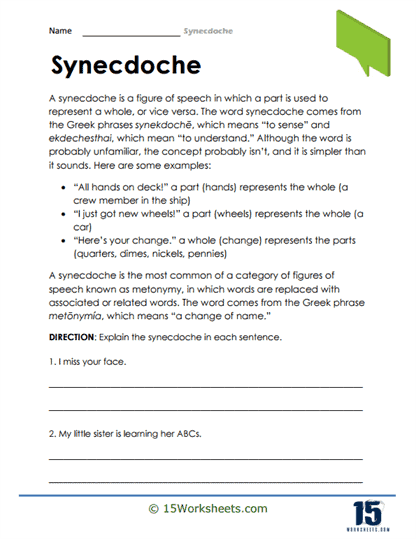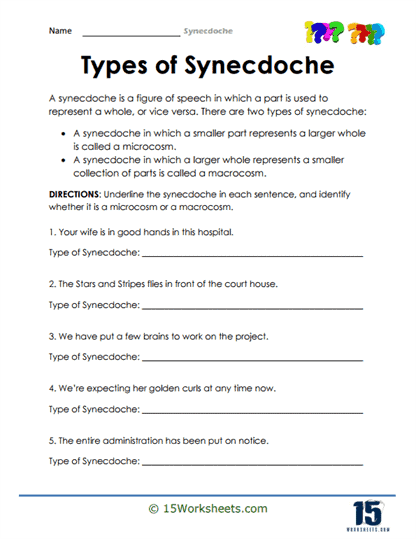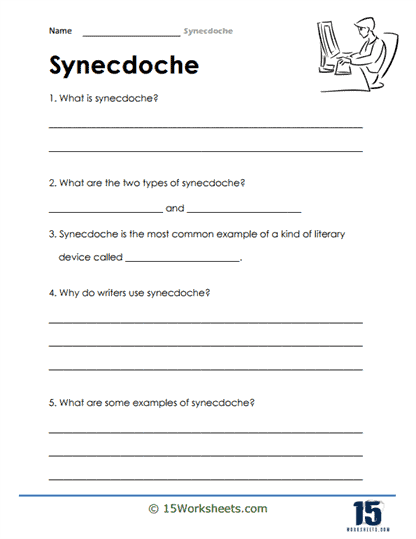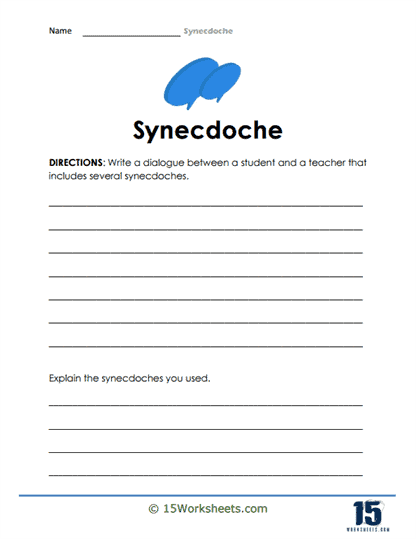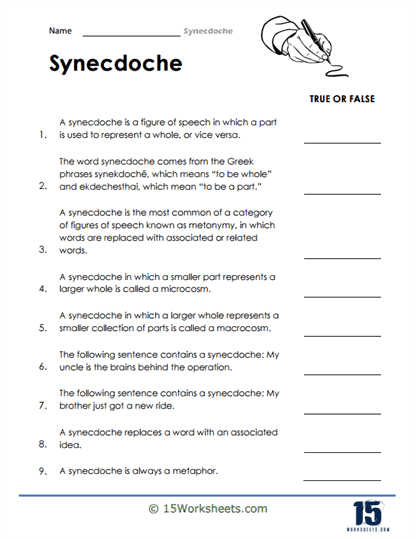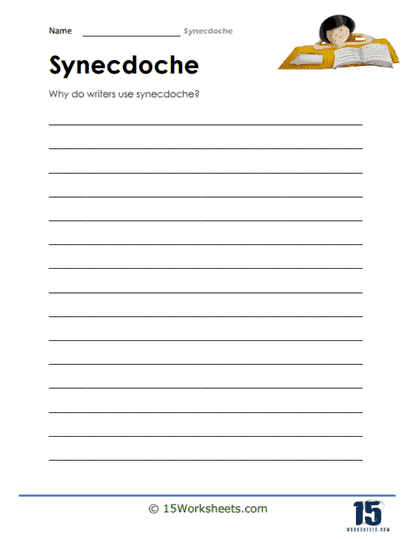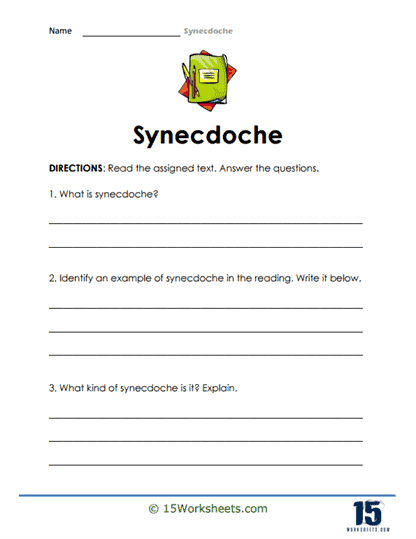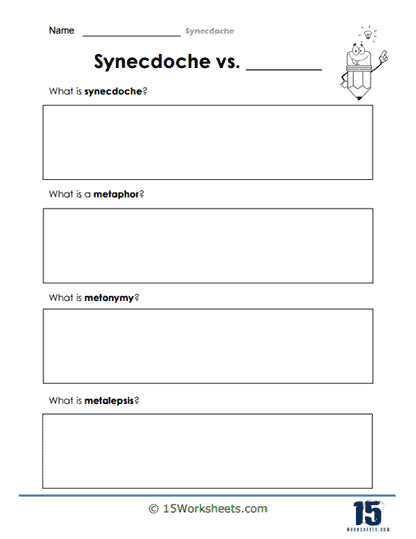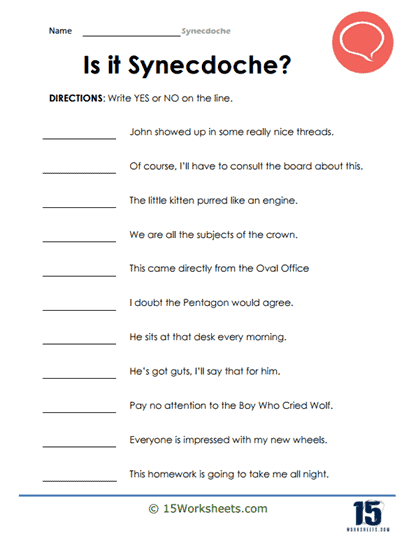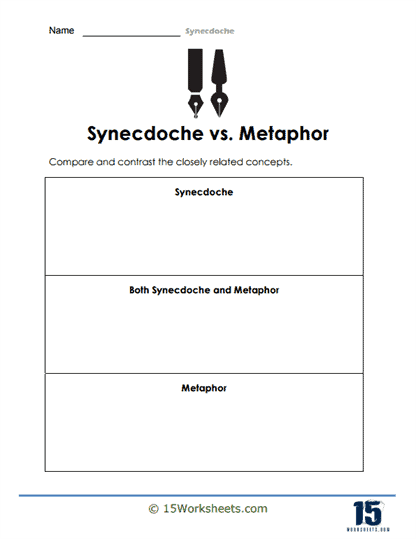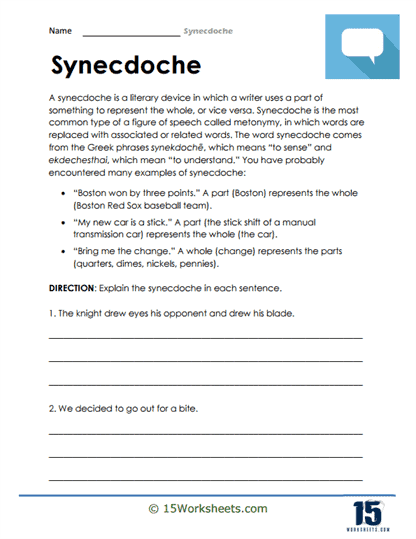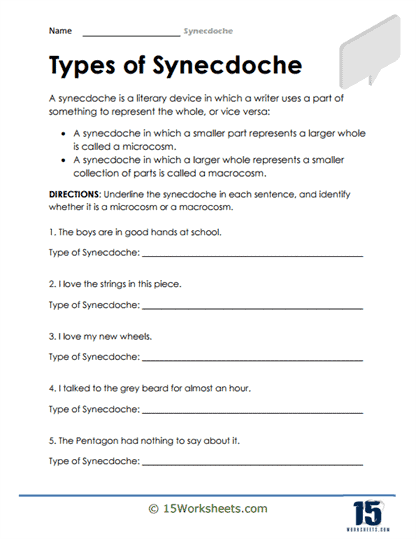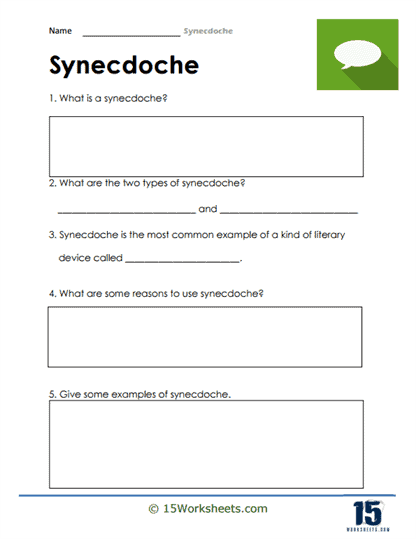Synecdoche Worksheets
All About These 15 Worksheets
Synecdoche, a figure of speech in which a part represents the whole or vice versa, is a captivating and versatile literary device that enhances language proficiency and fosters creative expression. Understanding synecdoche is not only important for mastering the subtleties of language but also for developing critical thinking, effective communication skills, and an appreciation for the richness of linguistic expression.
This collection of 15 worksheets is designed to introduce students to the world of synecdoche, helping them grasp the importance of this linguistic technique, recognize its various forms, and cultivate their own language mastery.
What Are Synecdoche Worksheets?
These worksheets help students understand and apply the concept of synecdoche. Synecdoche is a figure of speech in which a part is made to represent the whole, or vice versa. This concept can be somewhat complex, so worksheets can be a great way for students to practice identifying and using synecdoche.
Here’s what you might find in these worksheets:
Definition and Identification – The worksheets would likely begin with a definition and examples of synecdoche. Students might then be asked to underline or circle instances of synecdoche in provided sentences or short paragraphs.
Differentiating between Synecdoche and Metonymy – Since these two literary devices are often confused, some exercises might involve distinguishing between the two. Students could be given a list of examples and asked to classify each as either synecdoche or metonymy.
Creating Synecdoche – Once students have a grasp on what synecdoche is, some exercises could involve creating their own examples. This not only helps solidify their understanding, but also encourages creativity.
In Literature – Synecdoche is frequently used in literature, so worksheets might include passages from books or poems where students need to identify examples of this literary device. This can help students understand how synecdoche can add depth and creativity to writing.
Interpreting Synecdoche – Since synecdoche often involves a level of abstraction, some exercises could focus on interpreting what the author means by their use of synecdoche. This can improve critical thinking and reading comprehension skills.
The main goal of these worksheets would be to help students understand what synecdoche is, how to identify it, and why writers might use it. Understanding synecdoche can enhance a student’s ability to understand and analyze more complex literary texts.
What is the Literary Device of Synecdoche?
Synecdoche is a figure of speech where a part of something represents the whole, or the whole is used to represent a part. This rhetorical device allows writers to achieve conciseness, add symbolic layering to their text, or simply introduce a different way of describing something for artistic effect. Synecdoche is often confused with metonymy, another figure of speech, but the main difference lies in that metonymy uses a related concept to represent something else, while synecdoche works with a direct part-to-whole or whole-to-part relationship.
Defining Features of Synecdoche
The defining feature of synecdoche is its usage of a part to represent a whole or a whole to represent a part. It’s a form of shorthand, a way to represent something larger or more complex with something more simple or manageable. There are four types of synecdoche – part to represent the whole (using “wheels” to refer to a car), whole to represent a part (using “the law” to refer to a police officer), specific class to represent a whole (“bread” to represent food), and material to represent an object (“plastic” to refer to credit cards).
How Authors Use Synecdoche
Authors use synecdoche to create a more vivid, memorable experience for the reader. They often use synecdoche to convey character, setting, or theme more quickly and effectively than direct description would allow. Furthermore, synecdoche allows authors to build layered symbolism and meaning within their work, engaging readers on a deeper level. Synecdoche can also aid in characterizing speakers in a text as it reveals their perspective and how they view their world.
Examples of Synecdoche in Literature
“Moby Dick” by Herman Melville
In “Moby Dick,” Melville uses synecdoche when he has the character Ishmael refer to the captain of the ship as “the captain.” Here, “the captain” represents not just one individual, but the entirety of the ship’s authority and command. This synecdoche underscores the captain’s significance and his role as the embodiment of the ship’s authority.
“The Love Song of J. Alfred Prufrock” by T.S. Eliot
Eliot uses synecdoche when he writes, “I have measured out my life with coffee spoons.” Here, “coffee spoons” represent the small, mundane actions that make up Prufrock’s life. This synecdoche suggests that Prufrock sees his life as trivial and uneventful, a sentiment that is central to the poem’s themes of isolation and despair.
“Romeo and Juliet” by William Shakespeare
Shakespeare employs synecdoche when Juliet says to Romeo, “Thy lips, two blushing pilgrims.” Here, Juliet refers to Romeo’s lips as “pilgrims,” part of Romeo representing the whole. This metaphorical pilgrimage underscores the themes of love and devotion in the play, as well as the sacrilegious undercurrent of their relationship.
Benefits Of Synecdoche Worksheets To Students
Exploring the world of synecdoche through this collection of 15 worksheets offers students an opportunity to develop essential skills in language proficiency, literary analysis, creative writing, critical thinking, and cultural and historical awareness. Synecdoche is a linguistic device that invites students to appreciate the intricacies of language and explore the power of imagery and symbolism.
By engaging with these exercises and activities, students not only enhance their academic abilities but also gain valuable tools for effective communication, creative expression, and a deeper understanding of the dynamic nature of language in our ever-evolving world. The benefits of studying synecdoche extend far beyond the classroom, empowering students to be more expressive, eloquent, and culturally aware individuals in an increasingly complex and language-rich society.

